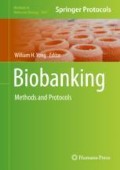Abstract
The purpose of a biobank is to process, organize, and maintain various types of biospecimens that are to be utilized for both clinical and research-based services. There are different types of biobanks, so the goals of the biobank should be delineated at the outset of forming a biobank. The startup of a biobank benefits from accreditation and stringent adherence to standards of practice. Fundamental to these practices is the protection of privacy and informed consent. A budget must be developed, and sources of funding should be obtained to properly equip the designated space and personnel. The appropriate space for freezers and for biospecimen processing should be identified. Information technology is also a critical part of the biobank and effort should be expended to ensure that this aspect is effective and secure. Given the ethical concerns surrounding biospecimens, engagement with the public is also highly valuable.
Access this chapter
Tax calculation will be finalised at checkout
Purchases are for personal use only
References
Shabihkhani M, Lucey GM, Wei B et al (2014) The procurement, storage, and quality assurance of frozen blood and tissue biospecimens in pathology, biorepository, and biobank settings. Clin Biochem 47(4–5):258–266
Krishnamurthy S (2014) Biospecimen repositories and cytopathology. Cancer Cytopathol 123(3):152–161. https://doi.org/10.1002/cncy.21505
Vaught J, Lockhart NC (2012) The evolution of biobanking best practices. Clin Chim Acta 413(19–20):1569–1575. https://doi.org/10.1016/j.cca.2012.04.030
Murphy J, Scott J, Kaufman D et al (2009) Public perspectives on informed consent for biobanking. Am J Public Health 99(12):2128–2134. https://doi.org/10.2105/AJPH.2008.157099
De Souza YG (2015) Sustainability of biobanks in the future. In: Karimi-Busheri F (ed) Biobanking in the 21st century, Advances in experimental medicine and biology, vol 864. Springer, Heidelberg, pp 29–35
EuroBioBank (2003) Outstanding ethical and legal issues on biobanks: an overview on the regulations of member states of the EuroBioBank project. http://www.eurobiobank.org/en/intranet/workflow/uploadDir/PDFmarcadoresEUROBIOBANK-ING.pdf. Accessed 29 Oct 2015
Biomedinvo4all: medical data and biobanks basics. http://www.biomedinvo4all.com/en/research-themes/medical-data-and-biobanks/medical-data-and-biobanks-basics. Accessed 30 Nov 2015
Riegman PH, Morente MM, Betsou F et al (2008) Biobanking for better healthcare. Mol Oncol 2(3):213–222. https://doi.org/10.1016/j.molonc.2008.07.004
The Virtual of Genomics (2007) Population-based biobanks and genetics research in Connecticut. http://www.ct.gov/dph/lib/dph/genomics/biobankspolicybrief.pdf. Accessed 13 Nov 2015
Asslaber M, Zatloukal K (2007) Biobanks: transnational, European and global networks. Brief Funct Genomic Proteomic 6(3):193–201. https://doi.org/10.1093/bfgp/elm023
ISBER (2012) Best practices for repositories: biopreservation and biobanking, 3rd edn. http://c.ymcdn.com/sites/www.isber.org/resource/resmgr/Files/ISBER_Best_Practices_3rd_Edi.pdf
Long-Mira E, Washetine K, Hofman P (2016) Sense and nonsense in the process of accreditation of a pathology laboratory. Virchows Arch 468(1):43–49. https://doi.org/10.1007/s00428-015-1837-1
Kang B, Park J, Cho S et al (2013) Current status, challenges, policies, and bioethics of biobanks. Genomics Inform 11(4):211–217. https://doi.org/10.5808/GI.2013.11.4.211
Master Z, Campo-Engelstein L, Caulfield T (2014) Scientists’ perspectives on consent in the context of biobanking research. Eur J Hum Genet 23(5):569–574. https://doi.org/10.1038/ejhg.2014.143
UCSF (no year listed) BioBanking at the University of California. http://ctsi.ucsf.edu/sites/ctsi.ucsf.edu/files/attachments/EngageUC_BriefingBook_English.pdf. Accessed 3 Nov 2015
Krawetz SA, Casson PR, Diamond MP et al (2011) Establishing a biologic specimens repository for reproductive clinical trials: technical aspects. Syst Biol Reprod Med 57(5):222–227. https://doi.org/10.3109/19396368.2011.604819
Souza YG, Greenspan JS (2013) Biobanking past, present and future: responsibilities and benefits. AIDS 27(3):303–312. https://doi.org/10.1097/QAD.0b013e32835c1244
Wolff AC, Hammond ME, Hicks DG et al (2014) Recommendations for human epidermal growth factor receptor 2 testing in breast cancer: American Society of Clinical Oncology/College of American pathologists clinical practice guideline update. Arch Pathol Lab Med 138(2):241–256. https://doi.org/10.5858/arpa.2013-0953-SA
Hewitt RE (2011) Biobanking: the foundation of personalized medicine. Curr Opin Oncol 23(1):112–119. https://doi.org/10.1097/cco.0b013e32834161b8
Canadian Tumor Repository Network (2011) Biobank certification: development of a program by Canadian Tumor Repository Network (CTRNet). http://biospecimens.cancer.gov/meeting/brnsymposium/2011/Posters/Suggitt-508.pdf. Accessed 5 Dec 2015
The microbiology blog (2008) Material safety data sheets (MSDS) for infectious agents. http://www.themicrobiologyblog.com/2008/08/material-safety-data-sheets-msds-for.html. Accessed 4 Dec 2015
Barbareschi M, Cotrupi S, Guarrera GM (2008) Biobanks instrumentation, personnel and cost analysis. Pathologica 100:144–148
Lean Laboratory Design—Case Study (2011) Leica biosystems. http://www.leicabiosystems.com/pathologyleaders/lean-laboratory-design-case-study/. Accessed 21 Dec 2015
Lou JJ, Mirsadraei L, Sanchez DE et al (2014) A review of room temperature storage of biospecimen tissue and nucleic acids for anatomic pathology laboratories and biorepositories. Clin Biochem 47(4–5):267–273. https://doi.org/10.1016/j.clinbiochem.2013.12.011
University of Texas: lab safety inspection checklist | Environmental Health and Safety (EHS). https://ehs.utexas.edu/programs/labsafety/safety-inspections.php. Accessed 3 Nov 2015
Tukacs E, Korotij A, Maros-Szabo Z et al (2012) Model requirements for Biobank Software Systems. Bioinformation 8(6):290–292. https://doi.org/10.6026/97320630008290
Yong WH, Dry SM, Shabihkhani M (2014) A practical approach to clinical and research biobanking. Methods Mol Biol 1180:137–162. https://doi.org/10.1007/978-1-4939-1050-2_8
About the NIH Common Fund. https://commonfund.nih.gov/about. Accessed 28 Oct 2015
Gottweis H, Lauss G (2011) Biobank governance: heterogeneous modes of ordering and democratization. J Community Genet 3(2):61–72. https://doi.org/10.1007/s12687-011-0070-0
Grants process overview | Grants.nih.gov. http://grants.nih.gov/grants/grants_process.htm. Accessed 4 Nov 2015
Applicant eligibility | GRANTS.GOV. http://www.grants.gov/web/grants/applicants/applicant-eligibility.html. Accessed 29 Mar 2016
Apply for Grants | GRANTS.GOV. http://www.grants.gov/web/grants/applicants/apply-for-grants.html. Accessed 29 Mar 2016
Acknowledgments
This work was supported in part by NIH:NCI P50-CA211015, NIH:NIMH U24 MH100929, the Art of the Brain Foundation, and the Henry E. Singleton Brain Cancer Research Program.
Author information
Authors and Affiliations
Corresponding author
Editor information
Editors and Affiliations
Rights and permissions
Copyright information
© 2019 Springer Science+Business Media, LLC, part of Springer Nature
About this protocol
Cite this protocol
Harati, M.D., Williams, R.R., Movassaghi, M., Hojat, A., Lucey, G.M., Yong, W.H. (2019). An Introduction to Starting a Biobank. In: Yong, W. (eds) Biobanking. Methods in Molecular Biology, vol 1897. Humana Press, New York, NY. https://doi.org/10.1007/978-1-4939-8935-5_2
Download citation
DOI: https://doi.org/10.1007/978-1-4939-8935-5_2
Published:
Publisher Name: Humana Press, New York, NY
Print ISBN: 978-1-4939-8933-1
Online ISBN: 978-1-4939-8935-5
eBook Packages: Springer Protocols

